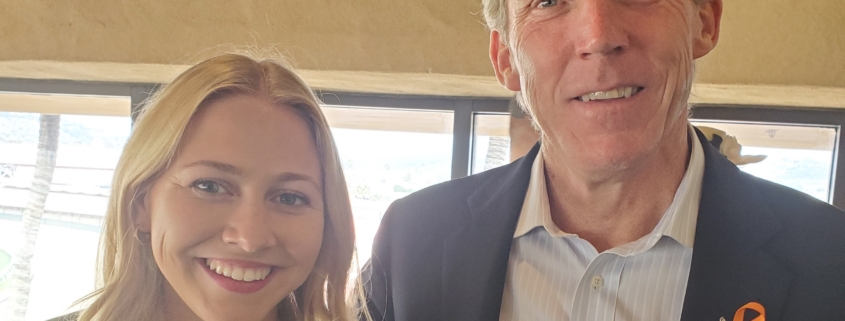John speaks with Marketer and Author Dan Albaum about his new book: The Impact Makers and how adaptability drives sales breakthroughs.
We asked Chris Gefvert, Director of Marketing & e-commerce at Allied Wire & Cable a few questions about how Marketing and Sales work together in his organization. Take a read below.
- Describe how your customer-facing sales teams use your organization’s marketing.
Our goal in marketing is to make the sales team’s job as simple and easy as possible. Full stop. Informing potential customers about the company before they speak to sales, saves a rep from pitching. Providing content educates them so reps don’t have to answer basic questions. Engaging them enough to raise their hand and request products saves the reps a game of cold phone tag. From the very start of the customer journey, each touch within our marketing operation acts as a force multiplier to sales efficiency.
- What is your Management’s approach to aligning sales and marketing?
In the B2B space, the common answer when each is asked about the other is usually “Marketing JUST makes pretty pictures, and Sales are JUST order-takers.” We’ve struggled with the paradigm of this unequal workload and impact perception between sales and marketing, and honestly, the root cause of misalignment is as simple as poor understanding. It’s a fascinating paradox that the two departments of an organization most skilled in communication are the ones at fault here, yet it is almost universal across industries.
We foster the understanding that both marketing and sales play an integral part in the customer journey and they’re part of one larger revenue operations team. Close-ready leads don’t appear out of thin air without marketing and there’s never a single cent of revenue without the sales team. To hammer home this idea of being on the same team, we developed a “RevOps Machine” diagram as a visual storytelling device to help align the teams for each campaign – almost like a technical flowchart of all customer touch points throughout the funnel. Whenever a new idea, campaign, or process improvement is communicated to either team, our Rube-Goldberg-like model is used and tiny customers are processed through each step to show the impact of even the smallest facet can have weight in the overall journey.
- How do you reinforce marketing messaging for your sales reps?
It’s an ongoing evolution – a perpetual cycle. Our marketing message is crafted by just listening to salespeople, not just in meetings, but on calls and emails with their customers, even in interactions with other salespeople on the floor. On a given day, our sales team speaks to countless more customers than we do in marketing, so it only makes sense to develop our messaging… well, right from the horse’s mouth. We take common themes, notable trends, and industry lingo and then root them in our brand and promotional messages as solutions to the customers’ current PBOs. It’s not so much us reinforcing marketing messaging for our sales reps, but them reinforcing our marketing messaging.
- What advice would you give to other marketing leaders as it relates to sales?
I cannot stress it enough – constant communication and feedback. Ask a sales rep at random “how did our last campaign positively affect you and your customers?” If they don’t give a glowing review, was it successful?
Take a full week and do a “ride-along” with different members of the sales team. Customer service, sales reps, key account executives, sales managers, everyone. Each has unique sales functions, day-to-day issues, even customer types, etc. and they all have a better pulse on YOUR target marketing personas than any focus group or CAB. As a marketer, a single day in the bullpen yields a month’s worth of customer and product knowledge.
Hana Van Voorst is our guest article writer this month. She just completed a 6 month role with us before heading off to France for Business Graduate School. Bon Voyage, Hana !
—————————————————————————
As I embark on a new journey to Montpellier, France for a Master’s in International Business, I’ve been reflecting on my time as a Marketing Researcher at Flannery Sales Systems (FSS). As a recent graduate of San Diego State University with a degree in International Business and Chinese language, I was very eager when John offered me an opportunity to work with their Marketing team. Although I didn’t know much about Sales, I was excited to learn. Little did I know, Sales would be just the beginning.
During my eight months, John gave me so many opportunities that weren’t just basic Marketing or Sales. Due to my interest in languages, I was assigned to work mainly with their translation and localization clients. This was a field of work that I never knew existed, but I was able to sit in on Sales training sessions with people from all over the world. I even got to participate in their training activities while coordinating the Zoom logistics. This active participation taught me about not only Sales but business in general. Whether you’re selling a product, an idea, or yourself, it’s more than just a transaction. It’s about establishing a credible relationship and focusing on the customer’s business objective and not just the product. This concept and many others that I learned through multiple trainings has given me a well-rounded perspective about the actual world of Sales instead of just the stereotypical one.
I also greatly enjoyed meeting new people with such a passion for languages. John set up separate networking calls for me to connect directly with these companies to gain more insight about the translation industry. I even met one client from France who helped me with my move to Montpellier including information about visas, accommodation, and French culture in general. This was such a great connection, and it made me feel more comfortable about my moving process.
These are only a few of the many things I gained in my months at FSS. John gave me the freedom and responsibility to problem solve with his guidance. I was able to learn project management, data analysis, and customer relationship skills while getting to work on assignments related to my passion for international business and language. As I pack for my move to Europe, I am so grateful for the opportunity to network with people and companies throughout Italy, France, the Netherlands, Spain, and so many more. This position has expanded my horizons to new people, new industries, and new skills. As I move forward in my endeavors, I plan to keep contact with FSS and would eagerly work for them again in the future.
This article was written by Dan Albaum of Market Impact.
Today’s Marketing organizations are evolving to be more accountable, quantitative and digitally focused than ever before. At the same time, market and competitive shifts have never been more dynamic, creating a need for highly adaptive teams using change as a catalyst for continuing improvement.
Market Impact has worked with high growth B2B technology companies across a wide range of segments and found the following “Vital Few” are crucial for Marketing to more clearly and effectively contribute to business success:
Master the Metrics
Justifying Marketing spending through measuring activity levels alone no longer cuts it in most businesses. Senior leaders demand seeing measurable results of Marketing activities from demand generation to events to PR and more that contribute directly to the overall company performance. CMOs and/or marketing leaders proactively participating in the formation of annual company objectives, and then linking Marketing objectives that are tightly aligned not only better focus the efforts of Marketing team resources but will ensure Marketing relevancy across the eyes in all functional departments. Creating a Marketing culture that craves numbers accountability (tracked consistently through easy to understand scorecards with no more than 3-5 priority measures) enables a faster, deeper understanding of what tactics work best, what tactics need adjustment or need to be dropped altogether.
Go all in on “Go to Market”
There’s no room for traditional Marketing and Sales silos in today’s highly successful companies. Creating tighter alignment through the formation of virtual Go to Market cross-functional teams where Marketing and Sales partner together in the definition of what is a quality lead and qualification criteria builds greater trust and speed in following up on sales inquiries. Establishing a defined cadence for reviewing together post “top of the funnel” sales follow up activity (ideally through fully implemented CRM systems) is a great start. Establishing no less than monthly interactive leadership calls reviewing demand generation tactics and sales follow up will over time turn the natural tension that often exists between Marketing and Sales organizations into a “we’re all in this together” mindset.
Commit to a Process
While a metrics focus and Go to Market team alignment are critical, to really pay off they must be part of a well-defined Go to Market process that ensures consistency in delivery, tone and message across all instances of customer touch. Unlike traditional sales processes that focus only on sales representative responsibilities at various stages from prospecting to close, a robust Go to Market process actively involves Marketing to incorporate a deeper understanding of discovered customer needs in top of funnel awareness, interest-building and PR influencer campaigns. These deeper customer insights are made possible by committing to researching target prospect needs, pain points and business objectives. Taking the time to profile decision makers and influencers, demonstrating great “listening” capabilities with confident playback of your understanding of needs that resonate not only accelerates sales but gives Marketing a much better opportunity to demonstrate measurable impact.
Today’s competitive and rapidly changing marketplace presents unique challenges for sellers and marketers. But by investing in a higher accountability metrics culture, fostering better Marketing-Sales alignment by creating Go to Market virtual teams and building consistency and discipline into a well-defined process, growth-focused organizations will pave a smoother path for future success.
Dan Albaum and Nikolett Bacso are Marketing Leaders at Market Impact, a trusted partner for B2B technology companies to elevate their brands for strategic growth.




